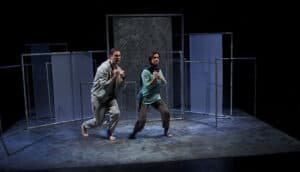
Actors Rehearsing for FREE on Verity Quinn‘s Set
I’ve lost count of the number of writers who’ve asked me the question ‘how do I ensure the play looks and sounds exactly as I imagined in my head?’.
*Newsflash*.
You can’t and it never will.
Also, if you think you really can totally imagine something as multi-layered as theatre in your head, by simultaneously doing seven people’s completely different creative jobs for them via the black and white marks you leave on a page, please tell me how you did it.
But if you’re doing your job as writer well, it might just look and sound even better than you imagined. All those new choices you weren’t expecting can be supporting your storytelling: deepening, enriching and layering nuance and meaning through the action you’ve carefully scored out in the form of spoken words, via costume, design, lighting, sound, music and movement (or at least some of these).
So what happens when you write a play where the boundary you’ve deliberately set yourself is that it could be performed with no set or lights or music, because the language is what shapes and drives the whole thing?
If you’ve deliberately imagined nothing, what are the costume, set, lighting and sound designers going to do?
If you’re lucky, they’ll do exactly what set and costume designer Verity Quinn did on FREE which toured last year with Half Moon Young People’s Theatre.
(I should be clear at this point that the script never states anywhere that the play should be performed without set, music, lights and so on: but writing it like that, for me, was about exercising the muscles of language as hard as I could without being able to fall back on something else doing the job for me).
When Verity began talking us through her design on the first day of rehearsal back in October, the language she used to describe the set was harmonising beautifully with the language of the play.
FREE was set mostly on rooftops in the Square Mile at night, expressing a landscape that is as alive as the free-running characters who traverse it.
Verity talked about opacity and translucence; the ethereal nature of sculptures in shadow that ghost in and out of our peripheral vision; the vanishing points of the horizon; the contradictions and tensions in the build materials she was using; an infinity floor that was flecked with broken symbols from an Arabic language subtly referencing one of the character’s lineage – in short, she spoke my play back to me in her own language, translating it into the vocabulary of design – texture, surface, shape, image, dynamic.
The set allows all of these things to resonate with the words, never imposing and offering a multitude of options in performance. It is metaphorical, not photographic; it asks the audience to use their imaginations to complete the picture; it helps the actors inhabit a fluid theatrical world that breaks the rules of the real and in every single way, it echoes the universe I believe the play creates for itself through the words.
There’s also lighting, original music and sound and a physical realisation of the story I didn’t even know could happen.
In other words, if you truly concentrate hard enough on your own job, you can enter into a beautiful conversation with other theatrical languages.
With any luck, the realisation of your work will become bolder than you ever could have imagined.
Enjoy? You can read more like this every Monday on Lane’s List: a weekly subscriber email that in 2014 distributed over 600 opportunities and industry articles for UK-based playwrights. You can read a sample list or find out more here.
This post originally featured in Lane’s List in Autumn 2014.